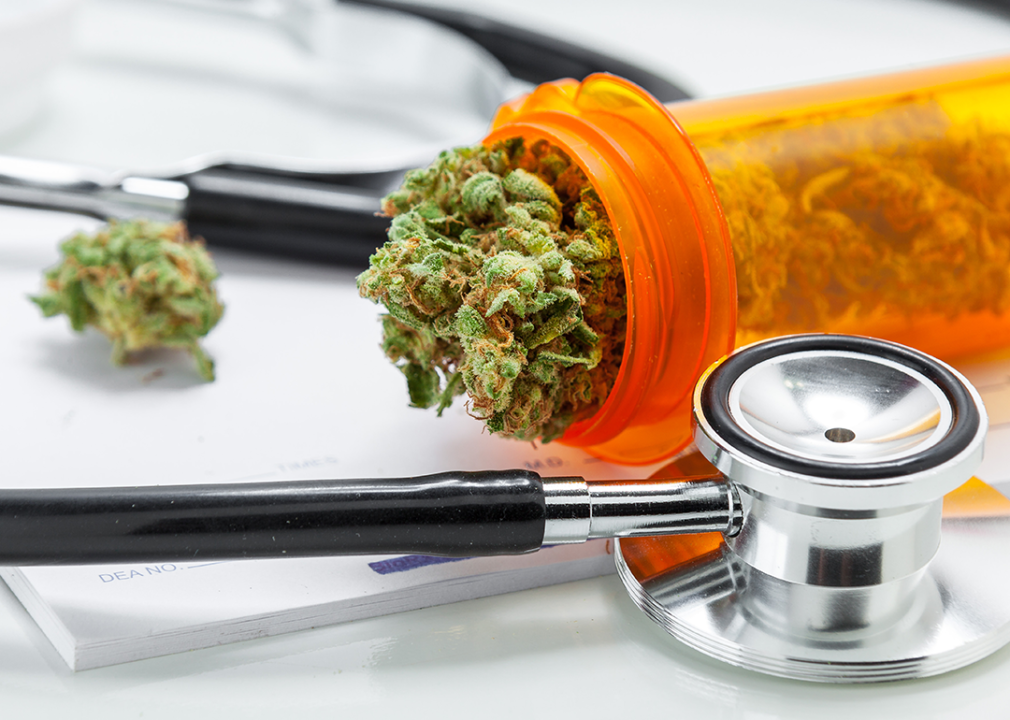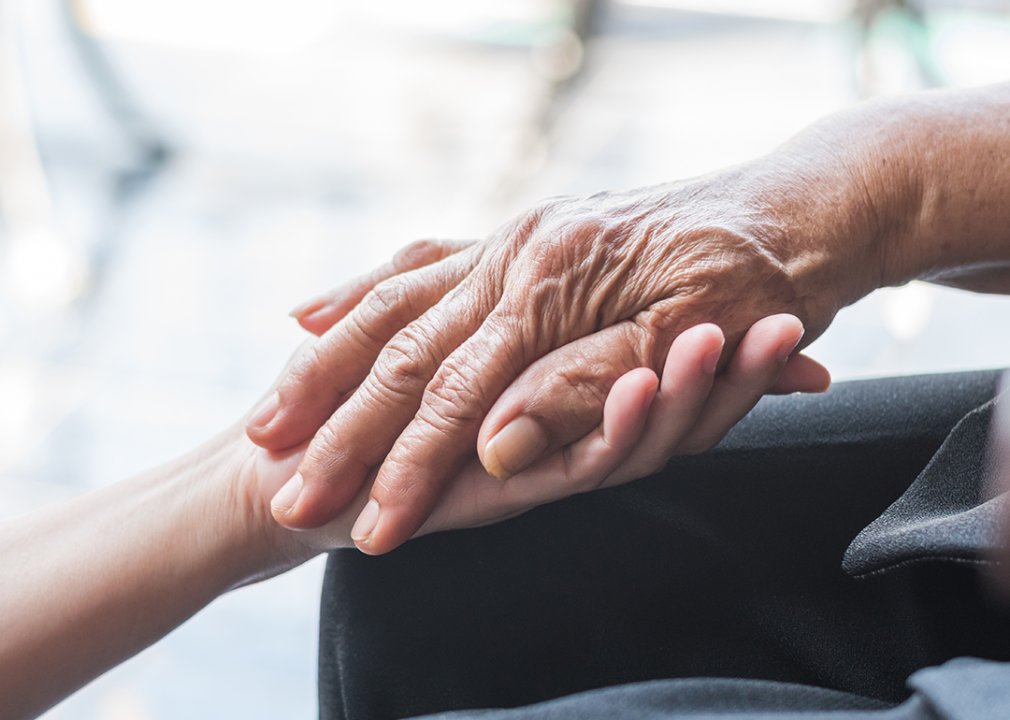8 emerging uses for medical cannabis

BestStockFoto // Shutterstock
8 emerging uses for medical cannabis
Medical marijuana with stethoscope and prescription.
Hope is on the horizon for people who want to use marijuana to treat medical conditions.
Cannabis is currently illegal under federal law as a Schedule I drug. But in January, federal researchers recommended moving it to a Schedule III drug, which includes drugs like ketamine and testosterone that are available by prescription.
Americans most closely associate medical marijuana with treating severe symptoms of cancer and AIDS. Indeed, the Food and Drug Administration has approved a handful of cannabis-derived drugs to treat these and a few other specific diseases. However, people living with many different medical conditions could potentially benefit from the reclassification and broader legal acceptance of cannabis.
Stacker identified eight medical conditions where cannabis may be beneficial, either by lessening symptoms or treating the underlying medical problem. Despite federal policy, the drug is already legal for medical use in 38 states, including Washington D.C., and is legal for recreational use in 25 states. Additionally, the medicinal use of cannabidiol, or CBD, often formulated as oil—which is made from cannabis plants but has low levels of their primary psychoactive element, THC—is allowed in six more states. Regulations vary widely between states—some are very restrictive, while in others, new laws have yet to be implemented, meaning cannabis is effectively illegal.
As legal recreational marijuana use has increased and stigma has decreased, the plant-derived drug has emerged as a potential treatment option for myriad conditions. Cannabis takes many different forms, which in turn can affect each person differently.
Common reactions to marijuana include a sense of relaxation and euphoria, and increased appetite. For the uninitiated, not all marijuana is created equal; various potencies and terpene makeups (the chemical compounds in cannabis that cause different effects like relaxation or heightened awareness) have a profound effect on the experience.
Anyone hoping to test cannabis to treat a medical condition should become familiar with their state’s laws first and speak with a doctor about treating the condition through more conventional methods. Under current federal law, doctors can’t prescribe marijuana, but instead can provide referrals for its use to those with qualifying conditions.
Even in states where cannabis is legal, obtaining a referral or license for medical marijuana can be challenging and may be impossible for many of the lesser-researched medical conditions. What’s more, federal restrictions have limited research into using cannabis to treat various conditions.
However, there are options for adults 21 and over in states where recreational marijuana use is legal, who can visit a verified dispensary to test the benefits of marijuana for their medical conditions. Research and cautious trial-and-error with cannabis products, including edibles, topicals, joints, and oils, can help those seeking relief find the proper dosage and method to manage symptoms.
Cannabis can have adverse effects that prospective users should be aware of: The drug can cause difficulty thinking and slow reaction times, impair memory, and, in high doses, can cause hallucinations and delusions. It also elevates users’ heart rate, and when smoked, marijuana irritates users’ lungs and can cause breathing problems. Use of cannabis while pregnant can negatively affect the fetus’ development.
Though there’s evidence that cannabis has been used for millennia to treat various ailments, modern research is only just beginning to provide scientific proof of its medicinal value. Although a more holistic understanding of its medical impact is still emerging, cannabis has proven beneficial for a variety of physical and mental health issues that have inflammation, anxiety, or stress as an underlying cause or major symptom.
Either anecdotally or through case studies and scientific research, people with these conditions have reported some therapeutic benefits of cannabis.
![]()

ldutko // Shutterstock
Seizures
Doctor listening to patient, both sitting at a desk.
Seizures are sudden and uncontrolled electrical bursts within the brain, which notably cause falls, uncontrolled flailing and stiffening, loss of consciousness, difficulty breathing, staring or rapid blinking, and lack of control of other bodily functions.
CBD, in particular, has shown promise to help control seizures, reducing their frequency and severity. CBD is beneficial for conditions that are resistant to other treatments. In 2018, the Food and Drug Administration approved a CBD medication to treat seizures associated with a severe form of epilepsy.

VGstockstudio // Shutterstock
Eating disorders
Cropped view of feet on scale and tape measure.
Eating disorders, especially anorexia, can cause dangerously low levels of body fat, which impede many mental and physical functions. Studies on using cannabis as a treatment for eating disorders are limited, but some have shown that cannabis helped those with anorexia regain healthy weight and eased other symptoms of the disorder, such as stress.
Keep in mind that eating disorders and substance use disorders often occur in tandem, so those using marijuana for treatment should be cautious about using the drug.

Andrey_Popov // Shutterstock
Psoriasis and eczema
Person scratching arm.
Psoriasis and eczema are similar skin conditions, both causing itchy, inflamed, and painful dry patches on the person’s skin that can crack and bleed. Cannabis can help target the underlying inflammation and symptoms of these incurable conditions.
Recent research shows that cannabis can calm inflammation and may even slow the overactive skin cell growth that causes dry patches. Cannabis and CBD products can also relieve pain, reduce itching, heal wounds, and manage stress (which often worsens these conditions).

pikselstock // Shutterstocck
Arthritis
Older man holding knee.
Arthritis is another inflammatory disease that primarily attacks joints in the hands, hips, and knees. Marijuana can relieve the inflammation and pain associated with arthritis.
People who have tested CBD to treat their arthritis have also reported improved sleep and reduced anxiety. Some studies have shown cannabis could even slow or stop the progression of the disease, but more research must occur to confirm those early theories.

Lordn // Shutterstock
Muscle spasticity
Patient speaking to doctor, both sitting at a desk.
Several medical conditions are primarily associated with muscle spasticity, or abnormal muscle tightness that prevents normal movement and causes involuntary muscle spasms and pain. These include multiple sclerosis and muscular dystrophy.
The THC in marijuana can relax muscles and temper spasms. Cannabis can also relieve pain, reduce muscle and nerve inflammation, and improve sleep.

Chinnapong // Shutterstock
Alzheimer’s disease
Close up caregiver holding senior hand.
Alzheimer’s—and dementia more broadly—affects millions of Americans each year, deteriorating parts of their brains associated with memory, reasoning, and other mental functions. Research is limited on the use of marijuana to treat these diseases.
Some studies have shown that high concentrations of CBD oil can relieve agitation and anxiety among Alzheimer’s patients, significant behavioral symptoms associated with the disease.

Alex Ost // Shutterstock
Crohn’s disease
Person holding their hands against their stomach as they are seated on the ground.
Crohn’s is characterized by digestive tract inflammation, which causes abdominal pain, diarrhea, fatigue, reduced appetite, and weight loss.
As an anti-inflammatory, cannabis can reduce these symptoms. Some Crohn’s patients report that cannabis has improved their quality of life by helping them manage pain, boost their appetites, and promote better sleep.

chayanuphol // Shutterstock
PTSD
Doctor holding a tablet, speaking with patient.
Post-traumatic stress disorder can plague anyone who experiences or witnesses a traumatic event, including combat veterans, victims of abuse, and survivors of sexual assault. Those with PTSD may experience severe anxiety, nightmares, flashbacks, intrusive thoughts concerning the trauma, and physical reactions to triggers.
A 2021 study in AIMS Neuroscience found that cannabis reduces symptoms of PTSD and improves patients’ quality of life; the drug decreased nightmares, improved sleep, and alleviated their perpetual fight-or-flight response.
Researchers have identified marijuana as a therapeutic tool to treat symptoms of many other illnesses not covered here, such as endometriosis, and other forms of chronic pain and mental illnesses. Consult with medical professionals, conduct research, and tread carefully when deciding whether using cannabis to treat a medical condition is right for you.
Story editing by Alizah Salario. Copy editing by Kristen Wegrzyn.





